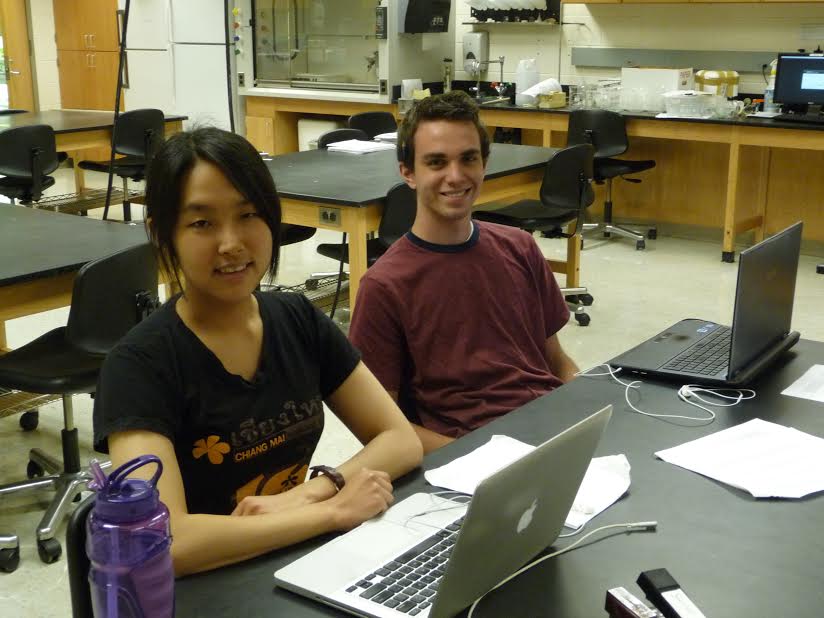Posters are springing up in the DeVries Hall lobby today for Calvin College’s annual summer research poster fair. Eighty-one students who participated in summer research will be presenting their studies from 12:30 to 3:30 p.m. this afternoon.
The presenters represent eight science departments: biology; chemistry and biochemistry; engineering; physics and astronomy; computer science; nursing; mathematics and statistics; and geology, geography and environmental studies. Each researcher worked with at least one of thirty-nine faculty members engaged in undergraduate-assisted research over the summer of 2014.
The projects are not only diverse in scientific field, but also in scope. Students conducted research everywhere from Calvin’s ecosystem preserve to broader West Michigan to out of state.
Audrey Hughey and Brian Hilbrands spent 10 weeks of the summer working with professor Johnathan Bascom of the geology, geography and environmental studies department. They built and published several chapters for an online Ethiopian geography text, emphasizing storytelling with the geospatial company Esri’s new “map journal” program.
“This was not a typical research project,” Hughey said. “A lot of this project was exploratory.”
Hughey and Hilbrands were members of a beta group for Esri’s “map journal,” which Hughey describes as a “‘map blog.’ You can think of it as maps with narratives in a blog or book format.” As a part of their project, Hughey and Hilbrands were able to visit Washington, D.C. to meet with Esri representatives.
“The object of our summer,” Hughey said, “was to figure out a way to use Esri map templates or products to make an online interactive textbook or textbook support for Ethiopian university geography classes.” In Ethiopia, unlike in the United States, geographical data is not shared publicly — yet. Perhaps because of this, there is a lack of geography textbooks in Ethiopia.
“There’s a wide variety of things you can get involved in [with summer research],” Hughey added. “It’s a cool way to get to know professors better as well, which is pretty valuable.”
Hughey and Hilbrands were not the only students studying beyond West Michigan. Junior Christopher Spedden and senior Daniel Van Noord conducted research on a cosmic scale, looking at binary stars — pairs of stars that orbit one another due to gravitational pull and appear as a single body, even when magnified. Binary stars typically have a well-defined period — the time it takes it make a full orbit — but the pairs that Spedden and Van Noord studied this summer exhibited sudden period changes that are not consistent with available modeling methods.
“This is something new,” Spedden said, “something that no model yet explains.”
Spedden and Van Noord worked closely with physics and astronomy professor Larry Molnar in the course of their summer research.
According to Spedden, the most significant difference between summer research and coursework is “the one-on-one aspect. I’ve learned so much more in my summer research than I would in a class on the same topic.”
Likewise, a poster presentation differs from typical verbal course presentations.
“It presents the information more concisely,” Spedden said. “A poster is the best way to make the information accessible to people unfamiliar with the topic.”
“I think you can get more opportunity to talk to people at a poster fair,” Hughey said. “A poster fair creates better dialogue between attenders and presenters.”
In addition to Hughey and Spedden’s work, 44 summer research projects will be on display this afternoon. External grants, private donors and internal funding from the college provided the financial backing for the projects, covering 46, 38 and 16 percent of the cost, respectively.
Students will be available by their posters to present their work and provide further information about the topics to the Calvin community.








